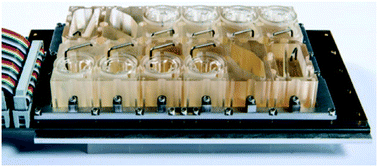A portable and reconfigurable multi-organ platform for drug development with onboard microfluidic flow control†
Abstract
The drug development pipeline is severely limited by a lack of reliable tools for prediction of human clinical safety and efficacy profiles for compounds at the pre-clinical stage. Here we present the design and implementation of a platform technology comprising multiple human cell-based tissue models in a portable and reconfigurable format that supports individual organ function and crosstalk for periods of up to several weeks. Organ perfusion and crosstalk are enabled by a precision flow control technology based on electromagnetic actuators embedded in an arrayed format on a microfluidic platform. We demonstrate two parallel circuits of connected airway and liver modules on a platform containing 62 electromagnetic microactuators, with precise and controlled flow rates as well as functional biological metrics over a two week time course. Technical advancements enabled by this platform include the use of non-sorptive construction materials, enhanced scalability, portability, flow control, and usability relative to conventional flow control modes (such as capillary action, pressure heads, or pneumatic air lines), and a reconfigurable and modular organ model format with common fluidic port architecture. We demonstrate stable biological function for multiple pairs of airway–liver models for periods of 2 weeks in the platform, with precise control over fluid levels, temperature, flow rate and oxygenation in order to support relevant use cases involving drug toxicity, efficacy testing, and organ–organ interaction.


 Please wait while we load your content...
Please wait while we load your content...